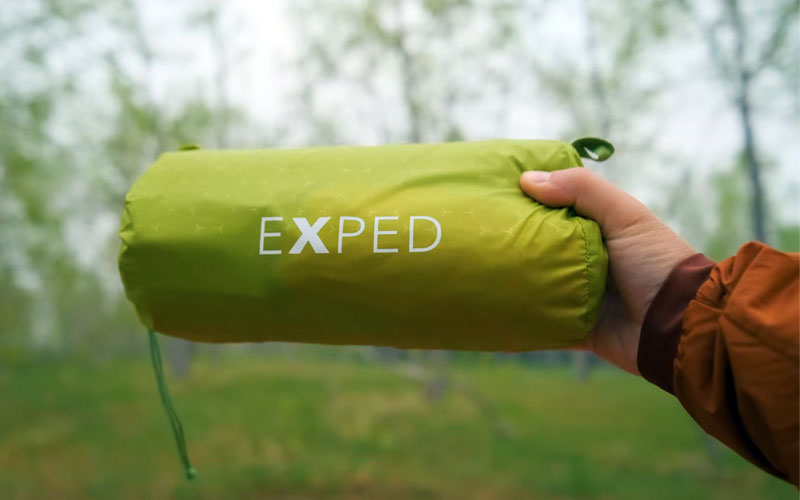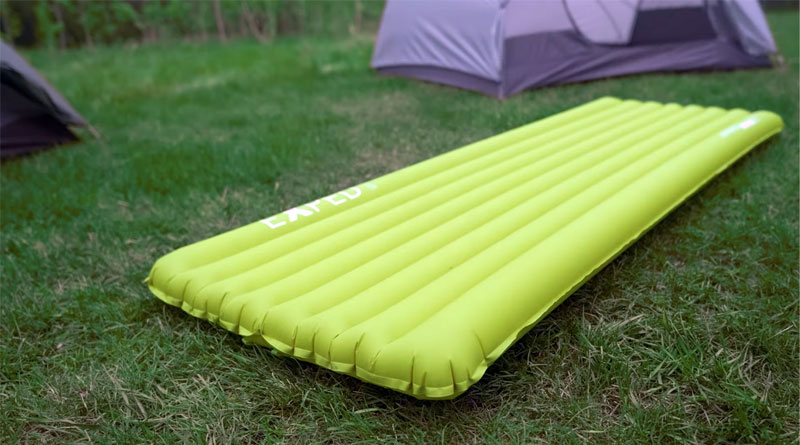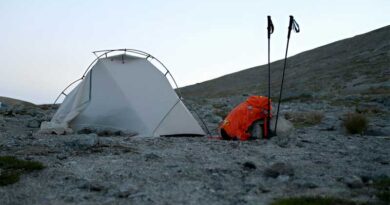Best Budget Ultralight Sleeping Pads of 2025
Finding the right sleeping pad can make or break your camping experience. When you’re on a budget, it’s tricky to balance comfort, weight, and cost. An ultralight sleeping pad is key for backpackers who want to travel light but still need rest after a long day. There are plenty of affordable options out there that don’t compromise on quality. In this guide, we’ll explore the best budget ultralight sleeping pads. We’ll focus on pads that are lightweight, comfortable, and won’t break the bank. Whether you’re a first-time camper or an experienced hiker, we’ve got options that fit your needs and your wallet.
1. Exped Ultra 3R
Weight: 1 lbs. 3 oz. (M)
R-Value: 2.9
Thickness: 3 in.
Dimensions: 72 x 20.5 in. (M)
The Exped Ultra 3R sleeping pad is a solid option for three-season use. Weighing just 1 lb. (Medium size), it keeps your pack light without compromising comfort. The mat is 3 inches thick, offering good cushioning on rough, uneven ground. Whether you’re on rocky terrain or rooty paths, it provides enough support to help you sleep well at camp. The internal synthetic insulation is laminated to both sides of the pad, ensuring consistent warmth throughout the night. With an R-value of 2.9, it offers moderate insulation, ideal for cool weather adventures.
Made with 20-denier, 100% recycled polyester fabric, this mat is incredibly lightweight. The nonslip finish helps keep you on the pad during sleep. Its internal hydrolysis-resistant laminate makes it durable, preventing damage from bacteria or moisture. The pad’s design includes welded baffles and internal air chambers that provide stability and eliminate cold spots. The vertical baffle orientation reduces welds, increasing the pad’s lifespan. Additionally, the oversize outer chambers form a Comfort Cradle, ensuring you stay centered. Inflation is easy with the included Schnozzel pump bag, which speeds up the process. While the Ultra 3R is excellent for cool-weather use, it’s not warm enough for shoulder seasons. For more insulation, you might want to opt for the 5R version. Overall, this sleeping pad offers a good balance of warmth, comfort, and durability, making it a solid choice for lightweight backpackers.
What I like: At just 1 lb. (Medium size), it won’t weigh you down on the hike.
What I don’t: The R-value of 2.9 may not provide enough insulation for colder conditions.
See the Exped Ultra 3R See the Ultra 3R Mummy
2. KLYMIT Insulated Static V Lite

Weight: 1 lbs. 4 oz.
R-Value: 4.4
Thickness: 2.5 in.
Dimensions: 72 x 23 in.
The KLYMIT Insulated Static V Lite is the cheapest option for campers looking for a lightweight and comfortable sleeping pad. Weighing only 20oz and packing down to a compact 8 x 3 inches, it’s easy to carry on any trip. The V-Chamber design helps the pad conform to your body, providing support for side, back, and stomach sleepers alike. With its unique insulation, it offers great warmth, even in cold conditions. The Klymalite synthetic insulation ensures that you stay warm while maintaining a good warmth-to-weight ratio. Plus, it’s easy to inflate, taking just 10-15 breaths to get it fully set up.
One of the standout features of this pad is its comfort. The V-Chambers limit air movement and keep the air pockets lofted, making it feel much like a mattress. The dynamic side rails provide additional support, helping you sleep soundly throughout the night. The pad stays inflated for long periods and deflates easily, saving you time. However, there are a few downsides. The pad doesn’t come with a pillow, which can reduce its length if you choose to add one, potentially making it a bit short for taller individuals. Additionally, the inflation valve is a bit flat, which may make it harder to inflate at first. But with a simple fix, like using a sports drink cup straw, it’s not a major issue. Overall, the KLYMIT Insulated Static V Lite is a great value, offering comfort, warmth, and ease of use, making it a top choice for anyone looking to upgrade their camping sleep setup.
What I like: Comfortable for side, back, and stomach sleepers with body-mapping V-Chamber design.
What I don’t: Potential difficulty finding leaks if the pad gets punctured (especially in cold conditions).
See the KLYMIT Insulated Static V Lite
3. Therm-a-Rest NeoAir XLite NXT
Weight: 13 oz. (Regular)
R-Value: 4.5
Thickness: 3 in.
Dimensions: 72 x 20 in.
The Therm-a-Rest NeoAir XLite NXT is an ultralight, ultra-packable sleeping pad that’s a major upgrade from its predecessor. It’s thicker, quieter, and packs down smaller, making it an excellent choice for backpacking and camping. Despite being lighter, it doesn’t sacrifice warmth or versatility, providing reliable comfort for year-round use. The pad inflates easily and stays in great shape, even after many nights of use. It’s an ideal option for anyone looking to save weight without compromising on performance.
In my experience, this sleeping pad is incredibly comfortable. I’ve used it for about 30 nights while backpacking and car camping in temperatures ranging from 20°F to 100°F. Throughout all these conditions, the pad held up well, providing consistent warmth and support. While it does get a bit warm on hotter nights, it’s not unbearable. The pump sack that comes with it works well for inflation, although it can be a bit clumsy at times. What I love most is the thickness once inflated, offering great support. I also chose the longer version to ensure comfort while side-sleeping. I can comfortably place my arm under my head without worrying about slipping off the pad, which was a great decision. Overall, the NeoAir XLite NXT is a fantastic sleeping pad that strikes the right balance between weight, comfort, and durability.
What I like: Extremely light and compresses down small, perfect for UL backpacking.
What I don’t: Higher price point compared to some other sleeping pads.
See the Therm-a-Rest NeoAir XLite NXT
4. NEMO Switchback
Weight: 14.5 oz. (Regular)
R-Value: 2
Thickness: 0.9 in.
Dimensions: 72 x 20 in.
The NEMO Switchback sleeping pad is a rugged, comfortable, and versatile option for backpackers. It features a closed-cell foam design with a heat-reflecting film that helps keep you warm by reflecting heat back to your body. The foam provides a great balance between comfort and durability, offering a supple top layer for rest and a resilient bottom layer for support. This makes it ideal for long-distance hikers who need reliable gear that can handle tough conditions. Unlike inflatable pads, the Switchback won’t get punctured in rugged terrain, which is a significant advantage when hiking through rough trails.
The pad also boasts an efficient, space-saving design. Its hexagonal nesting pattern allows it to pack smaller while offering more thickness. With 20% more space for insulation, the taller nodes help trap more warmth around your body, making it a great choice for colder nights. The Switchback is made with durable, abrasion-resistant Axiotomic™ foam, ensuring it can withstand years of use without losing its shape. Additionally, it’s versatile—use it alone for ultralight comfort or combine it with another pad for extra warmth during extreme conditions. It also has eco-friendly packaging made from recycled materials, reflecting NEMO’s commitment to sustainability. After trying the Switchback on rugged routes like the Hayduke and ODT, I can confidently say it offers solid performance for long hiking trips. Despite the compact design, it provides good insulation and comfort after long, hard days on the trail. I’m glad I switched from inflatable pads; no more worrying about punctures in the middle of nowhere.
What I like: Cheap and will never pop
What I don’t: It’s not as comfortable as an inflatable sleeping pad.
5. NEMO Tensor All-Season
Weight: 1 lb. (Regular)
R-Value: 5.4
Thickness: 3.5 in.
Dimensions: 72 x 20 in.
The NEMO Tensor All-Season sleeping pad is an excellent option for those needing warmth and comfort in all seasons. With a solid 5.4 R-value, it offers great insulation, making it ideal for four-season use. The pad’s design is well-thought-out, with the NEMO proprietary Spaceframe™ baffle system providing stable support and just the right amount of give. This helps maintain comfort throughout the night, while the suspended Thermal Mirror™ layers reflect body heat for extra warmth. The combination of these features ensures you stay cozy, even during colder months.
One of the standout features of the NEMO Tensor is its quietness. Unlike many other insulated air pads, it doesn’t produce the crinkling noise that can disturb your sleep. This is thanks to the floating construction of the Thermal Mirror™ layers. The pad’s durability is another strong point. The 20-denier nylon top and 40-denier nylon bottom protect it against punctures and tears. It also comes with a Vortex™ pump sack for quick and easy inflation, and the Laylow™ valve offers precise control over inflation, even in cold temperatures. The 3.5-inch loft provides plenty of cushioning, making it comfortable for side sleepers like myself. I’ve used the pad extensively while traveling, and even as a makeshift bed when I was sick. It performed well in all situations, so I’m confident it’ll hold up in the wilderness. At 5’6″ and 135lb, the regular size is perfect for me.
What I like: Slightly thicker, warmer, and cheaper than the NeoAir XLite above.
What I don’t: Small drop in comfort with the latest update.
See the NEMO Tensor All-Season
6. Sea to Summit Ultralight Insulated
Weight: 1 lb. (Regular)
R-Value: 5.4
Thickness: 3.5 in.
Dimensions: 72 x 20 in.
The Sea to Summit Ultralight Insulated Air Sleeping Pad is a great option for anyone looking for a lightweight and comfortable pad. It uses medium Air Sprung Cells™ to provide cushioning without adding much weight. With an R-value of 3.1, it’s perfect for late spring through early fall camping. The Exkin Platinum® fabric and Thermolite® insulation prevent heat loss, keeping you warm and cozy throughout the night. The 40- and 30-denier ripstop nylon face fabric strikes a good balance between lightness and durability, making it a reliable choice for backpackers and cyclists.
This pad is easy to inflate, deflate, and adjust the air pressure thanks to the multifunction valve. The built-in Airstream™ pump, which is part of the stuff sack, makes inflating quicker but still takes a bit of time compared to mouth inflation. The antimicrobial treatment helps prevent mold from forming when warm, moist air gets trapped inside. It also comes with a repair kit that includes six self-adhesive patches and a spare silicone 1-way valve insert, so you’re prepared for any field repairs. After three seasons of use and around 40 nights on bike trips and backpacking, the pad has held up well. Some people might find it a bit noisy, but I haven’t had issues with it. It packs down small and light, making it perfect for ultralight travel. While the pad is durable, I try to avoid punctures by being cautious around rocks. Overall, it’s a great choice for those looking for a lightweight and comfortable sleeping pad.
What I like: Lightweight and compact, easy to pack.
What I don’t: Pump sack takes a bit of time to inflate compared to mouth inflation.
See the Sea to Summit Ultralight Insulated
Budget Ultralight Sleeping Pads: Summary
| PAD | WEIGHT | R-VALUE | THICKNESS | DIMENSIONS |
|---|---|---|---|---|
| Exped Ultra 3R | 1 lbs. 3 oz. | 2.9 | 3 in. | 72 x 20.5 in. |
| KLYMIT Insulated Static V Lite | 1 lbs. 4 oz. | 4.4 | 2.5 in. | 72 x 23 in. |
| Therm-a-Rest NeoAir XLite NXT | 13 oz. | 4.5 | 3 in. | 72 x 20 in. |
| NEMO Switchback | 14.5 oz. | 2 | 0.9 in. | 72 x 20 in. |
| NEMO Tensor All-Season | 1 lb. | 5.4 | 3.5 in. | 72 x 20 in. |
| Sea to Summit Ultralight Insulated | 1 lb. | 5.4 | 3.5 in. | 72 x 20 in. |
How to Choose a Budget Ultralight Sleeping Pad?

Choosing the right sleeping pad for your backpacking trip is an essential part of ensuring a comfortable night’s sleep in the outdoors. While ultralight sleeping pads are popular for their portability and ease of use, finding a budget-friendly option that still offers the necessary support and comfort can be tricky. In this article, we’ll guide you through the key factors to consider when selecting a sleeping pad.
What is an Ultralight Sleeping Pad?
An ultralight sleeping pad is a compact, lightweight piece of gear that provides insulation and cushioning during outdoor activities like backpacking or camping. These pads help you stay comfortable while resting on uneven or hard surfaces, such as rocky ground or dirt. Ultralight sleeping pads are designed to be lighter and more portable than standard sleeping pads, making them an ideal choice for those who want to minimize the weight of their gear.
Why Go for a Budget Option?
Budget pads are a good choice for anyone looking to save money without compromising on too much comfort or quality. While premium models offer extra features such as advanced materials and extra insulation, an inexpensive option can still provide enough comfort for a decent night’s sleep. If you’re new to backpacking or don’t plan on using the pad frequently, opting for an affordable version can help you cut down on costs while still getting the job done.
Key Features to Consider
When looking for a sleeping pad, there are several important factors to keep in mind. These features can affect both comfort and performance.
Weight
One of the main reasons people choose ultralight sleeping pads is to reduce the weight of their backpacking gear. A lighter pad means less weight to carry on long treks. Most ultralight sleeping pads weigh between 0.5 and 2 pounds. If you’re on a tight budget, try to find a pad that’s as light as possible without sacrificing comfort.
Insulation
Sleeping pads provide more than just comfort; they also help keep you warm. Many budget options are made with materials that offer basic insulation. Look for options with foam or inflatable designs that provide some thermal resistance. The R-value of a sleeping pad measures its ability to insulate against the cold ground. A higher R-value indicates better insulation. While budget pads may not have the highest R-values, you should aim for one with a rating of at least 2.0 for basic warmth in moderate conditions.
Size
Sleeping pads come in different sizes to match your body shape and the type of tent you’re using. The most common size is a standard rectangular design, but there are also narrower and shorter versions that can reduce weight even further. If you’re looking to save weight and space, consider getting a shorter sleeping pad, which will still offer support for your torso but leave your feet exposed. However, if you need extra comfort and space, a full-length pad might be better.
Durability
When choosing a cheap lightweight sleeping pad, it’s important to consider how durable it will be. Cheaper pads might use lighter materials, which can wear out more quickly or puncture easily. Look for a sleeping pad made of durable materials such as high-denier nylon or polyester. While these materials may not be as robust as those found in higher-end models, they should still provide enough durability for light use in backpacking and camping trips.
Inflation and Setup
Inflatable sleeping pads typically provide the best comfort-to-weight ratio, but they can be a hassle to inflate and deflate. Budget options may not have built-in pumps or easy-to-use valves, so be prepared to do the work manually. Some pads use foam or air cores, which require less effort to inflate but can be bulkier. If you don’t mind spending extra time setting up your pad, an inflatable option might be a good choice. However, if you want something more straightforward, a self-inflating foam pad could be a better alternative.
Popular Sleeping Pads
Several well-known brands offer ultralight sleeping pads with a balance of comfort and affordability. Though they may not have all the high-end features of premium models, these pads still meet basic needs and provide good value for money. Some popular options include the Therm-a-Rest Z Lite Sol, the Klymit Static V, and the Coleman Self-Inflating Sleeping Pad. These pads are widely available and generally receive positive reviews for being comfortable, affordable, and functional.
How to Maximize Comfort on a Budget?
While the cheapest options might not offer the same luxury as higher-end models, there are a few tricks you can use to improve comfort without spending extra money. First, make sure the pad is fully inflated or properly adjusted to your desired firmness level. You can also add a layer of foam or a lightweight blanket underneath the pad for extra cushioning and insulation. Additionally, consider using a sleeping bag liner or sleeping pad cover to protect your pad and enhance its comfort.
When to Consider Upgrading
Budget sleeping pads are perfect for beginner backpackers or those who only go on short trips occasionally. However, if you find yourself backpacking frequently or in extreme conditions, you might eventually want to upgrade to a higher-end sleeping pad. Upgrading can give you better comfort, increased durability, and more advanced insulation. Additionally, more expensive pads often come with added features such as a thicker design, quieter materials, and built-in pumps for easier inflation.
Conclusion
Choosing the right sleeping pad requires balancing comfort, weight, insulation, and durability while keeping costs low. By considering the factors outlined in this article, you can find a sleeping pad that suits your needs without breaking the bank. Remember, even a budget pad can provide a comfortable night’s rest if you take the time to choose wisely. Whether you’re new to backpacking or looking for a reliable option for occasional trips, a sleeping pad can make all the difference in ensuring a good night’s sleep on the trail.









